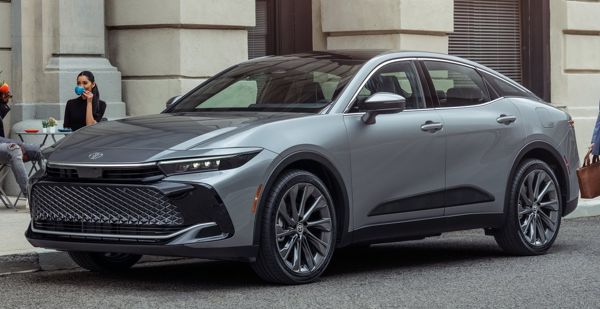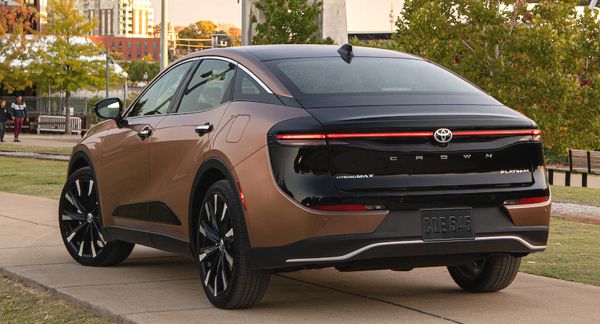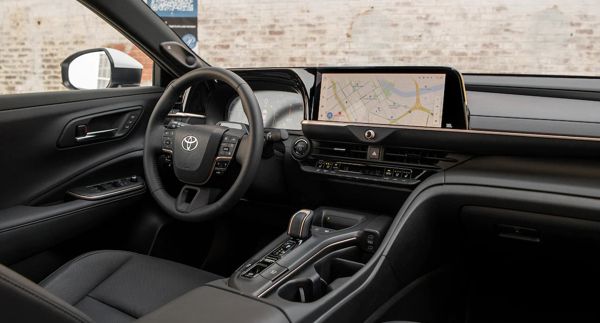Published
on 11
Nov 2022
|
All rights reserved.
|
|
|

|
|
Crown
is converted to a crossover, but its substances barely change.
|
|
When
rumours about the 16th generation Crown would be turned into an SUV
crossover leaked out last year, it sounded to me that it was the end of
a long story. The new crossover would be just a Crown by name, a trick
to keep the long serving nameplate (since 1955) exist. So it is a shock
to see Akio Toyoda standing in front of not just a new crossover but 4
different looking cars carrying the same "Crown" label at the press
conference in mid-July. While none of them can be said carrying the
bloodline
of traditional Crown, they do start a new chapter and hopefully could
secure the future of the brand.
The old Crown has to be put into grave, because there is simply no
market prospect for a non-German mass production luxury sedan these
days, especially when sales is bounded in Japan. Even though Crown was
famous in its home market, there are simply too few customers to keep
it profitable. In its hey days, it sold more than 200,000 units a year,
but that dropped to only 22,000 by 2020.
But the new generation should be different. When Hiroki Nakajima, the
boss of Toyota's mid-size cars division, presented his proposal for the
16th gen model to Akio Toyoda almost 3 years ago, Toyoda thought its
evolution was too mild and requested his guy to come up with a more
radical proposal. Nakajima came back with not one but 4 cars, including
the leading proposal of a crossover, which is the car in discussion
here. Surprisingly, they were all greenlighted by Toyoda. The big boss
wants to turn Crown into a sub-brand with multiple models living under
it, much like Ford is doing to Mustang.
So here comes 4 different Crowns with different shapes, functions and
market positioning. They will be sold globally in 40 countries and, if
all goes according to plan, will capture 200,000 sales a year.
The crossover Crown is the first to reach showrooms in Japan and North
America, where it has been absent for exactly 50 years. It looks like a
jacked-up sporty sedan, with a streamline shape, sexy waistline yet
offering crossover kind of high ride height and elevated seating
position (about 100mm higher than conventional sedan), which brings a
commanding view on the road that motorists love these days. It rides on
the TNGA-K platform of Camry, Avalon and Lexus ES, so goodbye to
longitudinal powertrains and rear-drive, welcome transverse engine
driving the front wheels and an electric rear axle. Suspension is
predictably MacPherson struts up front and multi-link setup at the
rear, while AVS adaptive dampers is available to top trim.

|
|
While
the lower half is SUV-lookalike, the upper half mimics a 4-door coupe.
|
|
Unlike the aforementioned platform-mates, the Crown Crossover won't be
offered with V6 engine. There are still 2 powertrain options, but both
are 4-cylinder hybrid. The base powertrain is basically the same as
that of Camry Hybrid, Avalon Hybrid and ES300h, consists of 2.5-liter
naturally-aspirated engine and Toyota's traditional hybrid system with
a planetary CVT and 2 motors. It offers a combined 236 horsepower, 21
up from its cousins, but remains oriented to fuel efficiency and
smoothness rather than performance. That’s why it achieves a remarkable
41 mpg in EPA combined cycle. A 54-horsepower electric motor is used at
the rear axle to offer 4WD functionality, but only when under demand,
such as slipping. In normal driving, the car is front-driven.
The premier powertrain employs a 2.4-liter turbo four, good for 272 hp
alone, while the hybrid system is completely different. Instead of
planetary CVT, it uses a 6-speed automatic transmission with a
multi-plate wet clutch so that it can offer quicker response. There is
only
one electric motor up front, housed within the transmission casing and
does the job of both propulsion and regeneration, so not quite as
energy efficient (30 mpg combined). An 80-horsepower, water-cooled
electric motor is employed at the rear axle. This means it can provide
permanent 4WD that the base powertrain cannot. The rear axle can
receive up to 80 percent torque if needed, but never falls under 30
percent. System output is 350 horsepower in Japan or 340 in the US,
accompanied with 406 lbft of torque. Both powertrain options employ
Toyota's bipolar NiMH battery pack mounted under the rear seat.
Strangely, neither full electric nor PHEV version is planned. This
means the new Crown is unlikely to be sold in Europe.
The Crown crossover is a bit longer and wider than the outgoing Crown
sedan. The chief difference is height, which is 85 mm taller. However,
at 1540 mm it is still noticeably lower than most other crossovers, and
that’s why we don’t classify it as an SUV. While the lower half of the
car is every bit SUV-lookalike, the upper half mimics a sleek and low
4-door coupe. The proportion is therefore very strange, but nonetheless
interesting.

|
|
Comfort
is still on first priority.
|
|
Inside, the design is less adventurous. A wide transmission tunnel
separates the front occupants. The dashboard and switchgears are
conservatively shaped, but build quality is decent. It is not up to the
standards of Lexus though, because the lower you look the more hard
plastics you can touch.
You sit high in the car, but its ride height is just marginally higher
than that of a Camry or Avalon, so its offroad capability is nearly
zero. Meanwhile, the GT roofline is relatively close to your head,
meaning it offers no benefit in cabin space at all. The boot is smaller
than that of Avalon, too. While it looks like a hatch, its fastback is
fixed, and you access the boot through a relatively small opening. The
new Crown places style over function.
To drive, it is not too bad, especially if you are not keen drivers.
The naturally aspirated base model does the comfort job well, offering
a smooth and refined manner while delivering outstanding fuel economy.
It takes 7.6 seconds to go from 0-60 mph, not bad. Push harder uphill
or overtake on highway and its CVT could drone the engine, hampering
refinement, but generally it offers enough punch for everyday driving.
Meanwhile, the turbocharged engine is far punchier, cutting 0-60 to 5.7
seconds, and its gearbox is
more responsive (if still occasionally denies downshift requests). The
permanent AWD also helps the Turbo to cut understeer in corner.
The Crown is quite responsive to steer, but the initial turn-in is
followed by excessive body roll and understeer, blame to the high
center of gravity and a comfort-oriented suspension tuning. The Turbo’s
adaptive dampers helps a little when switched to Sport mode, though
fails to transform the car into a proper driver’s car. The car’s
nearly 2 tons of weight also puts a lot of burden to the braking.
However, if you are not fooled by its look and understand that the
Crown is always supposed to be a luxury car, you may be easier to
appreciate it. No matter how radical or different it looks now, its
substances barely change. Maybe Akio Toyoda is right. What defines
Crown is not its shape, powertrain layout or engine configuration, but
the fact that it aims to bring luxury motoring to the mass market. From
this perspective, the 16th generation just works in the way as the 1955
original.
|
Verdict:   
|
|